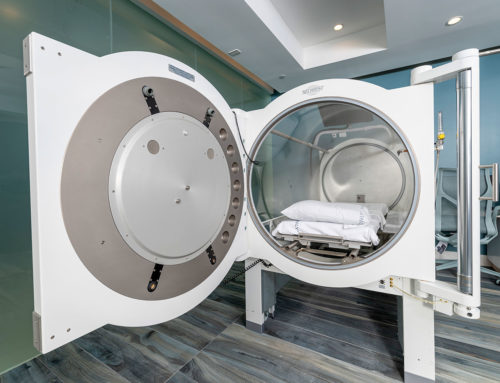Hyperbaric oxygen therapy can truly be a life changing treatment option for many patients. Study after study has shown it to be effective in healing many different diseases and conditions ranging from decompression sickness and carbon monoxide poisoning to diabetic foot ulcers and thermal burns. On top of these FDA-approved uses, more studies are showing HBOT’s potential effectiveness in treating migraines, depression, PTSD, and more.
In the beginning, though, it’s natural to have many questions and concerns regarding HBOT. Below, you’ll find answers to some of the most frequent questions and concerns to help calm any nerves, and ensure you’re making an informed decision.
How Does HBOT Treatment Work?
Hyperbaric Oxygen Therapy (HBOT) is a type of treatment that involves providing high-pressure oxygen to individuals while they’re enclosed in a hyperbaric chamber. The air pressure is slowly increased to higher-than-normal levels (up to two to three times), and the environment is pumped full of 100% oxygen.
Under these conditions, the patient’s lungs can collect more oxygen than would be possible at normal air pressure, and potentially increase healing at a more rapid than normal rate.
The therapy may last anywhere from 60-120 minutes while the pressure increases, and then is returned to normal levels.
What Are the Potential Side Effects?
Possible symptoms or side effects after HBOT can include fatigue and lightheadedness. While in the chamber, the patient may also feel pressure on their ears, much like you would while taking off in an airplane.
Is There Any Reason I Should Not Receive Hyperbaric Oxygen Treatment?
Hyperbaric oxygen therapy is not safe for everyone. In general, you shouldn’t receive HBOT if you:
- Have certain types of lung diseases
- Have a collapsed lung
- Do not like small, tight or enclosed spaces (claustrophobia)
- Are sick: cold, fever, flu, etc.
- Have had a recent ear injury/surgery
Always check with your primary doctor before starting any type of treatment.
Preparing For HBOT Treatment
Here are a few tips on how to prepare for HBOT treatment.
- Clothing is provided by the treatment center, usually in the form of 100% cotton scrubs or gowns, as cotton is the safest material for the oxygen-rich environment of a hyperbaric chamber.
- Arrive with a clean, natural body, meaning no deodorants, dyes or perfumes, or any petroleum-based skin products. Also, accessories such as jewelry, wigs, glasses, etc. are prohibited.
- Alcohol and carbonated beverages should be avoided at least four hours prior to HBOT treatment. Abstaining from these substances for a least a couple of weeks before treatment is also highly advised.
- Stop smoking – If you are a smoker, try to stop smoking for the length of your treatment as tobacco can block your body’s natural ability to transfer oxygen.
- HBOT treatment could affect certain medications, so talk with your HBOT technician about all medications and/or prescriptions you are currently taking.
- Reschedule your appointment if you are sick, because a cold, fever or flu could interfere with treatment.
What Do I Do Inside the Hyperbaric Chamber?
The short answer: lie comfortably and relax! Many patients take a nap, and some HBOT chambers offer TV and music. Technicians at the facility will be with you every step of the way and watch over you through the entire length of your session, to ensure your comfort and safety.
Does HBOT Treatment Hurt?
Most people report a painless experience during HBOT treatment. However, because the pressure is so high, some people may feel minor discomfort while in the chamber, such as a popping or fullness sensation in the ears, much like being in an airplane.
How Long Will Treatments Last?
For most, hyperbaric oxygen treatment will last approximately two hours, although the duration could be shorter depending on your condition.
What Happens After HBOT Treatment?
After your session, your technician will assess your vitals, including looking in your ears and taking your blood pressure and pulse. If you have diabetes, your blood glucose is checked. After everything checks out, you are free to get dressed and leave at your leisure.
Many patients report feeling tired or hungry following treatment, but generally your recovery time is very quick, and you can resume your normal activities immediately.
Is HBOT Covered by Insurance?
HBOT is often reimbursable by Medicare and most other third-party insurance carriers for certain conditions. In most cases, pre-authorization should be obtained prior to treatment.
Hopefully, this rundown of some of the most-often-asked questions and concerns will reduce any anxiety or fear regarding hyperbaric oxygen treatment. HBOT is a very safe, effective, and pain-free option for healing, but please feel free to discuss any additional concerns not covered with your physician and our team.
World-Class HBOT
At Aalto Hyperbaric Medical Group, you can discover a safe, painless, and non-invasive alternative to traditional treatments They are scientifically proven to treat a number of temporary and chronic conditions that other medicine may not address. Schedule an appointment with us today at 1-888-303-HBOT, or email us anytime at info@aaltohyperbaric.com.
RELATED POSTS
GET STARTED TODAY
Schedule an appointment with us today by calling (310) 507-7942 or using the contact form below.discover thisread what he saidelfbar 3500company website


